Musings
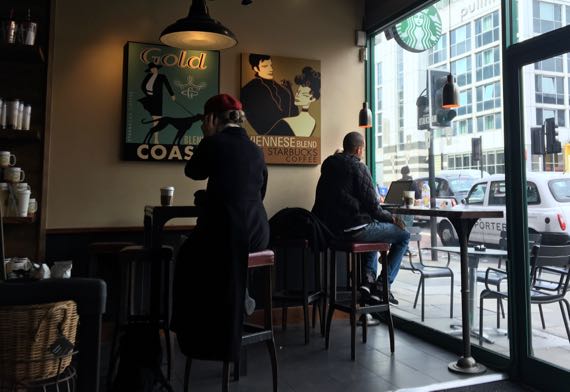
The great switch day began with packing up. Despite how small our Ikea-sized room was, I kept finding little stashes of belongings that needed to be en-luggaged.
Eventually, we made our way to the BritLibrary Sbux, and gained functioning brain cells by astute application of caffeine and internet-time.
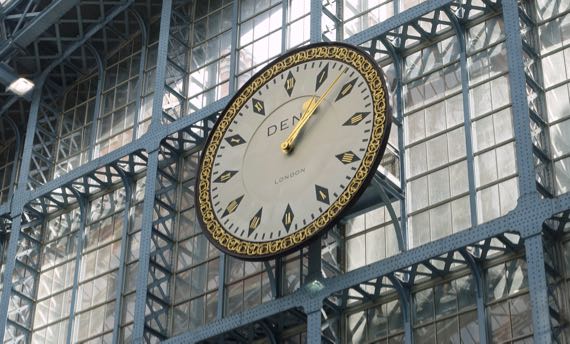
Then, a short roll to St Pancras for our pending international departure…. Soon, we were rolling at fast-train speeds. Overcast for our entry into France. Spring seems more sprung here.

We had dressed for morning-London temps, and arrived in afternoon Paris-warmth, so adjourned to fast showers before heading out to an auberge (really a restaurant) that seemed well-reviewed on the web. We liked the posted menu and the street-appeal and strolled in. Tables available—yippee! This was our dessert, a house specialty, a trio of shuffles, each with a matching sauce/liquid added—chocolate (of course), caramel (out of this world buttery sauce), and Grand Marnier.
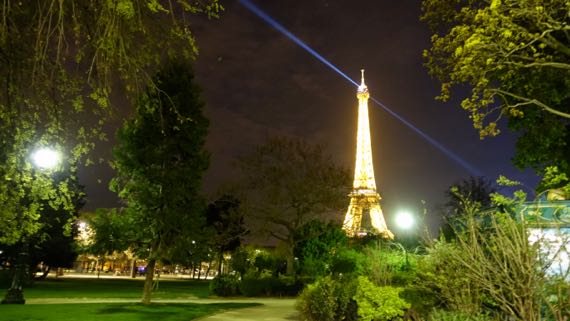
Our after-dinner stroll was to, where else…. Don’t remember the blue spotlights. Look how leafed out the trees are here….
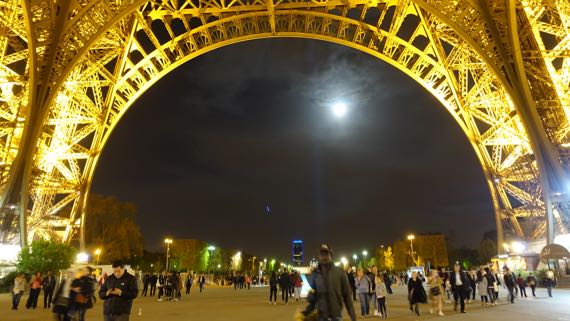
And looking back from the river, there’s the moon. Can you say romantic?
Posted at 10:22 PM |
Comments Off on London ➙ Paris
We added serendipity to our planning, spurred by the diminution of water to our flat. Management claimed it was a problem for all their properties and across the immediate area. (Shower later, I thought.) So, we headed to Starbucks for an energy boost, then took the train over to the V&A, founded 1852 and now with 145 galleries (I read that; I did not count even the ones I entered). Whew. Here’s a tiny sampling of the sample that we saw.

Sion gospel book, cover/binding dates to ~AD 1140-1150; central panel of Christ probably later.
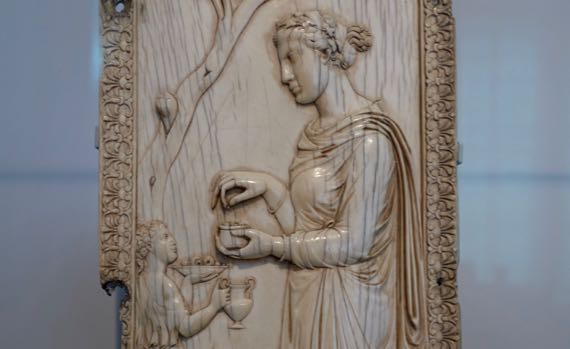
Carved ivory panel portraying a pagan (non-Christian) ceremony probably celebrating Dionysus, Symmachi family, Rome, AD 400. This was after Constantine declared for Christianity for the Empire, and during the time that both persisted. Heavy-featured priestess, no?
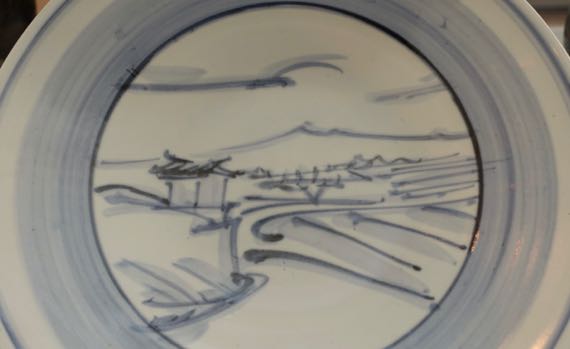
Tomimoto Kenkichi painted pottery plate, 1931. Friend of Bernard Leach’s from Tokyo.
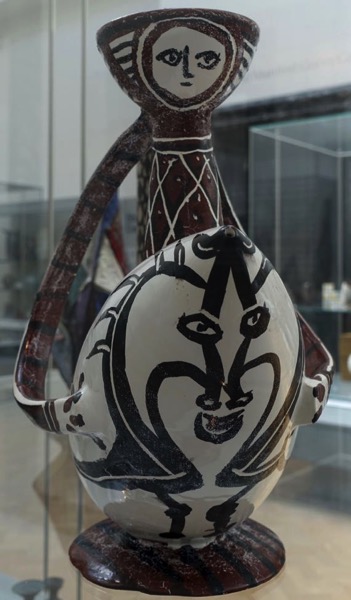
Pablo Picasso, 1950–51, “Cavalier sur sa Monture.” On that web page, the V&A says, “Picasso successfully challenged traditional divisions in the arts world and made a major impression on a new generation of potters.” (It’s Picasso, so it’s a big pic.)
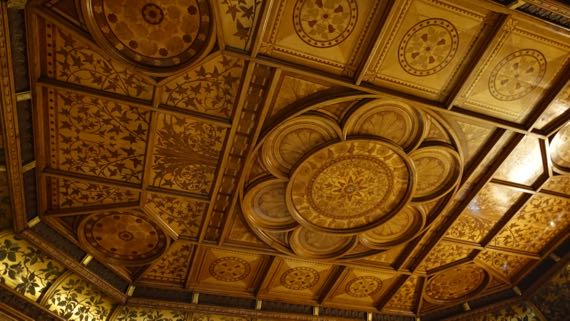
Ceiling of the ante-room of the 1877–78 home, The Grove, in Harborne, near Birmingham. Designed by John Henry Chamberlain; woodwork by Samuel Barfield. The V&A got the room just before the building was demolished in the mid-1960s.

Now somewhat faded due to the use of natural dyes, this hand-knotted piece was co-designed by William Morris and John Henry Dearle, and is called the Bullerswood Carpet, as it was made for John Sanderson’s house in Kent, called Bullers Wood some places. The design elements are drawn from nature. Date:1889.
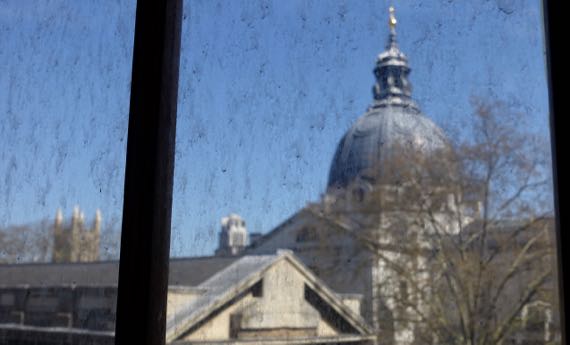
View through dirty window. And this is paved, clean London. Think what it used to be like….

On to Harrods (founded 1834; apparently now owned by Qatar Investment Authority), first for lunch and then to browse. This was my lunch, grilled Dover sole with hollandaise sauce, a glass of sancerre, and a side salad of rocket and shaved parmesan, with a lovely, light vinaigrette that included fine-chopped shallots. Oh, yum. We went in honor of the pre-Al-Fayed history, and the extensive offerings. Probably won’t go back—too much merchandise with Harrods imprinted on it and too commercial in general; however, food tasty and high-quality in food hall and this seafood grill.

Bluetooth speakers with bone-shaped remote.
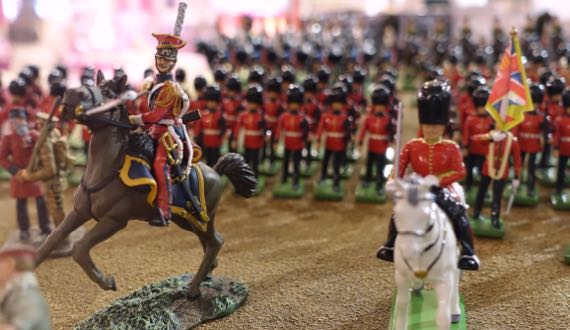
“Army men” display in Toys section.
Off to nearby Hyde Park to sit in the sun, and…
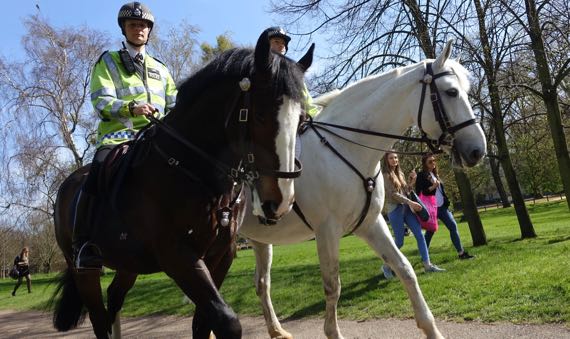
…heard an incoming clop-clop, and had mounted police come by our sun-bench…
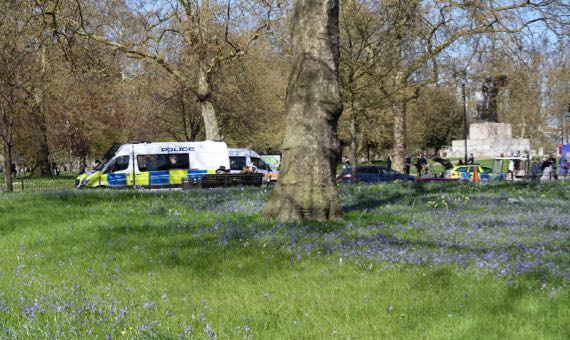
…and saw a meadow of bluebells foregrounding…police vehicles as we left the park. We can say: police presence, no?
Water’s back on and we’re recovering in our flat (all feet are tired; whole of The Guru is tired.)
Posted at 2:06 PM |
Comments Off on Serendipity and plans
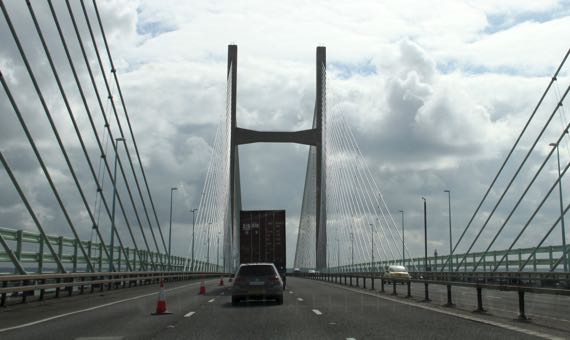
The Severn Bridge we took into Wales opened in 1966. I bet traffic patterns changed immensely, even with the substantial toll. In 1996, the Second Severn Crossing opened; set a bit downstream, it especially carries vehicles flowing to/from southwest Wales, including Cardiff and Swansea. The powers-that-be had the two combined into a single concession to share toll collection and debt repayment. So, we entered Wales on the old bridge (not that old), and left on the new bridge. Bye-bye Wales, we are London-bound with two Roman stops en route.
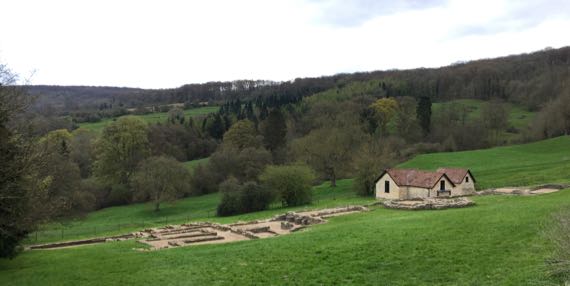
Discovered in 1818, this modest Roman villa commanded the upper area of a smallish drainage, and was built into a hill. Construction began in the AD 250s, and the place was abandoned in the early 400s, when the Roman military pulled out of Britannia. The mosaics are under the roof. The place was ours to visit, quiet except for distant pheasant squawks and generic country sounds.
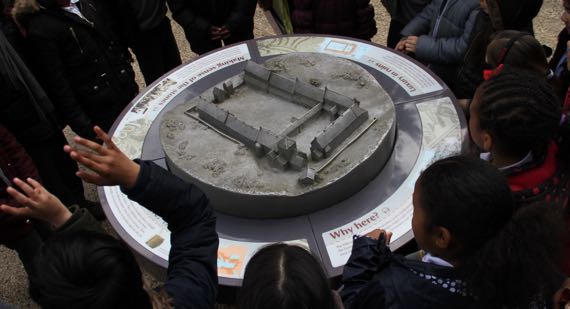
Chedworth Roman Villa, on the other hand, was bustling with docents and vendors, school groups, walkers, and generic tourists. The complex grew over about the same period as the previous villa, and also was set into a hill’s upper slope. This complex became much larger, and much more architecturally elaborate. It ultimately had two bath areas, for example. In this view of the metal maquette, uphill is to the lower right, with the lower, larger courtyard planted into a garden that opens to the upper left (actually east) and views of the valley.
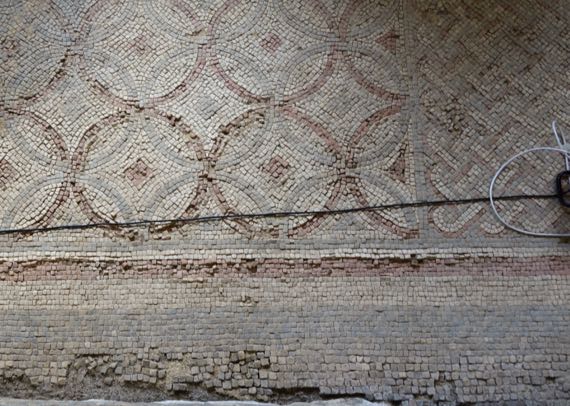
This was among the earliest mosaic floors at Chedworth, along a passageway in the upper “horizontal” bank of rooms that faced the valley (late AD 200s). The earliest construction was up here, three separate buildings that eventually became a single “range” of attached rooms.
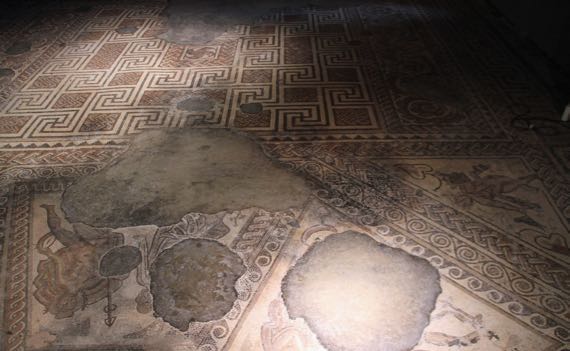
In the early 300s, this elaborate dining room was added, with considerable wealth invested in the floor. This was a typical choice of elite homeowners, as the dining room was the principal location for entertaining (plus the decorative gardens).
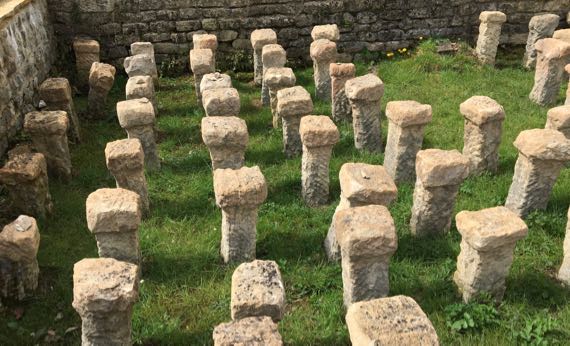
Love the mushroom pillars of the hypocaust floor…. It seems to me that more rooms than in a Rome-area Roman villa had heated floors, I’m assuming because they had the water/firewood to make the heat, and because it was colder than Rome here, and this was how elites made living in the colonies more like life at the imperial center, and thus more Roman.
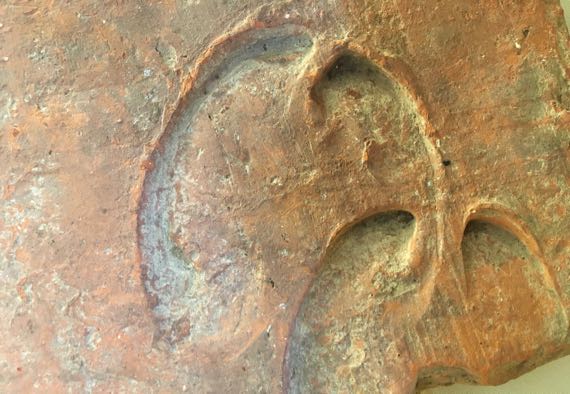
Just one detail from the museum, from the display of impressions in roof tiles. The tiles were made locally, but probably not on the villa property. These are ox-hoof impressions. Other displayed examples were dog, cat, human fingers….
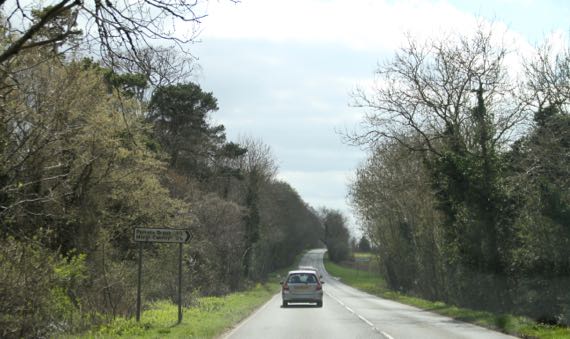
Within ten miles of Chedworth are eleven villas, including Great Whitcombe that we visited earlier today. Chedworth is between two roads that radiate in a northerly direction from Cirencester. We misheard our navigation-voice say that place as Siren-sister (hence today’s title); it’s pretty close. While that sounds like the Roman name, it isn’t; the Roman name was Corinium Dobunnorum. During the time of the villas, Corinium also had many domestic complexes with elaborate mosaic floors and other markers of wealth. Money could be made here, both through agricultural pursuits and through regional and long-distance trade. Anyway, this modern road follows Fosse Way, the Roman route to the NNE out of Corinium. The complete Fosse Way went NNE from Exeter to Lincoln (today’s names).

En route around Heathrow’s runways to the car rental return, we again noticed these little human transporters on a rail. I only got this one crappy picture, at a distance. These self-driving units are called pods, and the service is aimed at business travelers, linking a special parking lot with Terminal 5. It opened in 2011.

Our London home is an Ikea special. The folding chairs are actually from Ikea. If you have long arms, you can almost make coffee from the bed. We have a window with a park view and wifi; life is good.
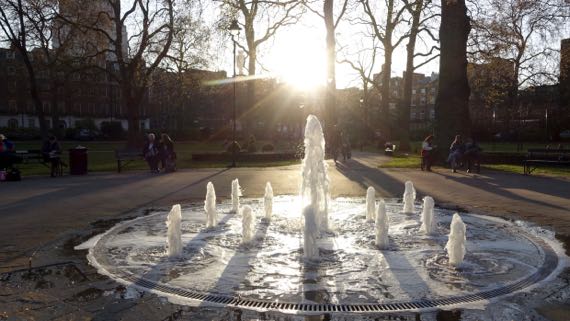
We took off for the Thames and points en route. We thought we might take the train back, but hoofed it the whole evening. Here’s a fountain in a nearby park (not our window-park). We saw several groups sitting on the grass enjoying an early meal/snack.
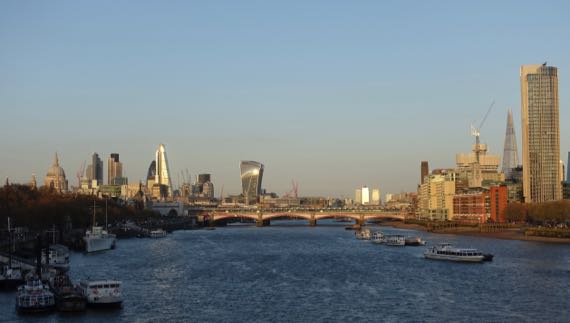
We saw the Thames in the last of the day’s light. And heard Big Ben chime at 8pm.
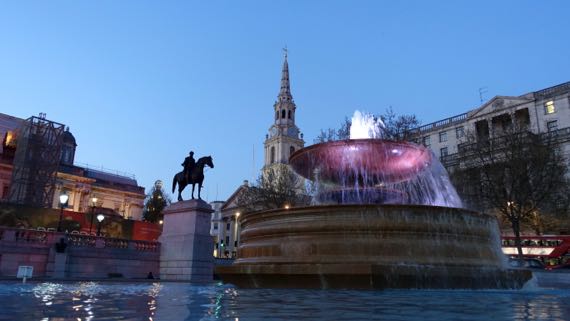
Turning north, we entered Trafalgar Square. Fountains. Spires. Blocky buildings. Man-on-horse statues.
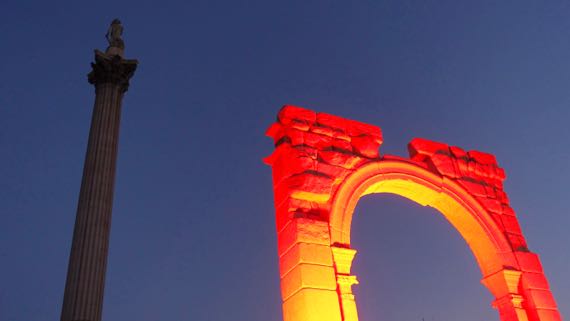
And…Admiral Nelson towering over a red glowing Roman arch. Art. The Guardian says it’s a Carrara marble replica of Palmyra’s Arch of Triumph, recently destroyed by Daesh/Isis. It is here for three days and gorgeously lit.
Posted at 10:22 PM |
Comments Off on Siren-sister
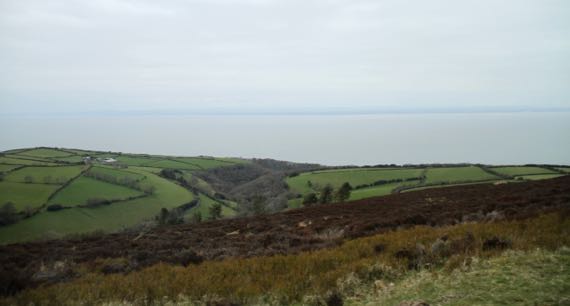
Fog on the moor this morning. Love the visual contrasts of, from front to back, the uncultivated moor, the quilt of fields separated by hedges, the sea, the Wales coast, and the muted sky.
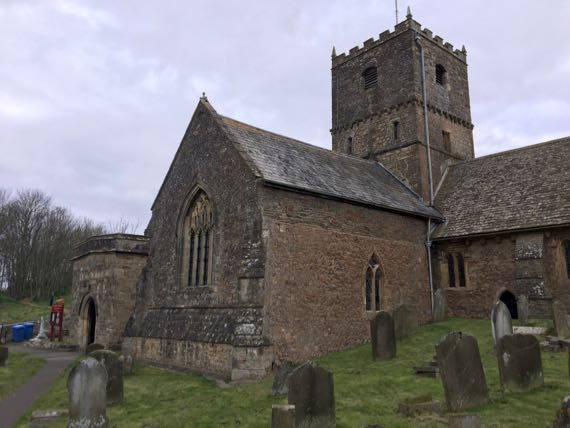

Quick stop in Clevedon to see several places used as the town in “Broadchurch”—including this church, St Andrews in real life. This is a living church, as it were, with a gravedigger (man and machine) busy opening a new spot and prayer books shelved by the door.

Then, farther up the coast, we turned west to cross this Big Bridge, the pleasure for which we paid the princely sum of £6.60. Of course, leaving Wales is no charge…just a one-way fee collection plan…perhaps to encourage the English to leave but not to visit?
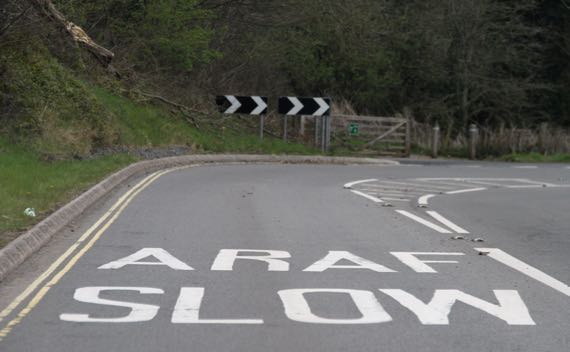
Welsh lesson: ARAF means slow. Sometimes they’re in the other order. (I was going to make the title of this post “post wan,” which translates as “weak bridge,” a not uncommon phrasing on a sign on a country lane.)
And, now for Tintern’s church ruins. It is mostly commonly referred to as an abbey, and it was, but most photos are, frankly, not of the monastery, but of the church.
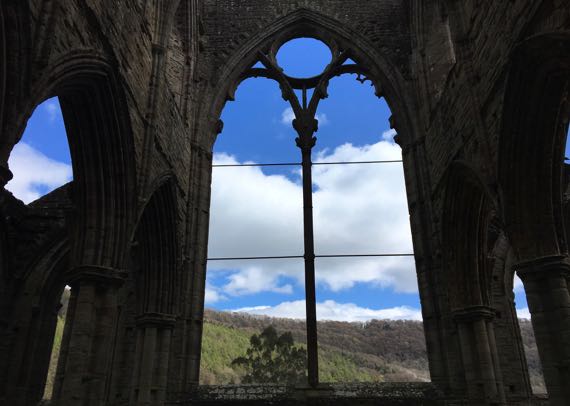
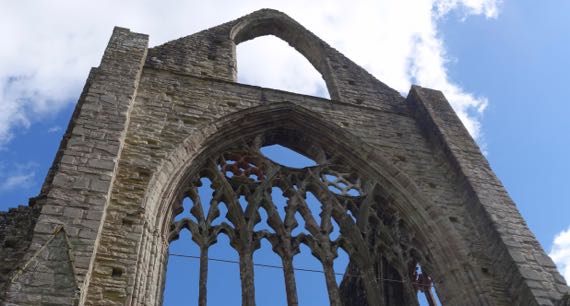
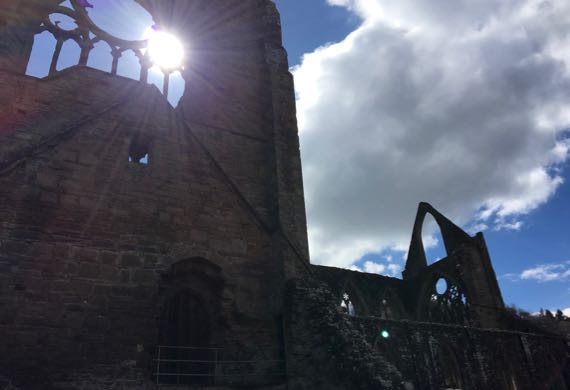
First, the window opening above the east, altar end of the main hall. Second, the newly restored upper window area of the opposite, west (door) end. North transept, wall of high window openings extending to west end.
The light was transcendent.
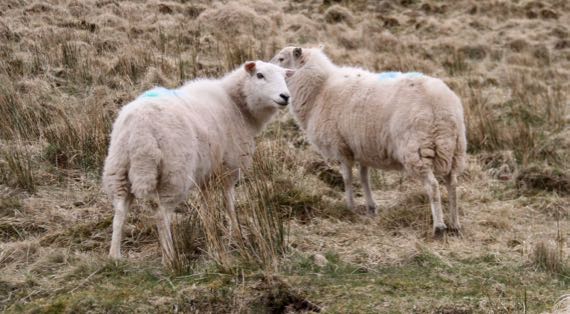
Today is our first visit to Wales. Signs are different—bilingual. Sheep seem the same to us non-shepherds.

And this is the National Assembly building in the dock-front area of Cardiff. Shipping is not what it used to be and this zone is being repurposed to draw locals and visitors. While somewhat commercialized, there are also stunning modern and historic buildings. And glittering water, wheeling gulls, and, for a while just for us(!), late-afternoon warm-toned sunshine.
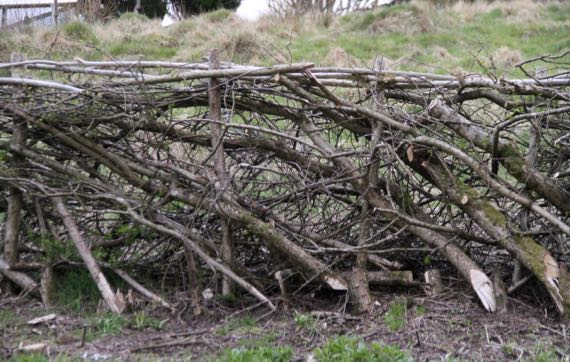
Here’s a closeup of a living fence, mentioned yesterday. This one has the uprights just bent to the side, rather than all the way horizontal. After growing, it has the same effect of making a latticework impenetrable to sheep, cattle, and people. Small birds, rodents, and other small creatures may well make their home here….
Posted at 10:22 PM |
1 Comment »

Whatever you think you know about Tintagel Castle, it’s probably wrong. The King Arthur association, no chance. The rocky almost-island has plenty of ruins, mostly dating to three periods, the Dark Ages (here AD 500–600s, roughly), the 1200s, and to Victorian times. The DA ruins are pretty humble and meager. While the landform is defensible, there’s little else to recommend it—not much area to grow food and everything’s rocky, although the harbor situation for small watercraft is workable if the seas are relatively calm (says this landlubber). The “castle” dates to about 1230, including the ruins of a Great Hall and Chapel (the most recognizable architecture). The Great Hall had to be modified as part of it slid into the sea not long after it was constructed. The rest of what commonly constitutes a castle—not here or only small bits. The Victorian modifications look like versions of a folly to me….

Here’s the Great Hall…. Both these pictures show Tintagel’s most salient feature: elevation changes. This is rough terrain. Note that the bridge below (far below) my shadow is steps—not flat. See: terrain!
We were glad it was only breezy (and not windy) and not rainy (and slick underfoot) during our Tintagel visit. BTW, that big, chunky, rectangular building on the far hill is a hotel. Great location for them; bit of an eyesore from Tintagel.
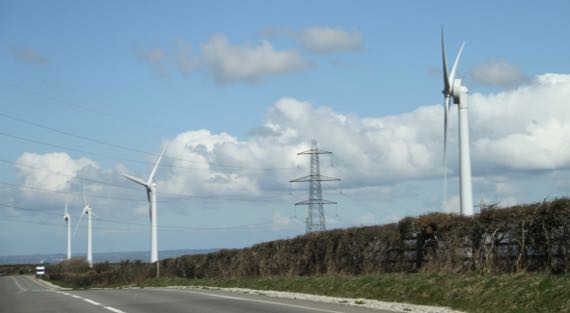
Wind generators…all busy generating—none still.
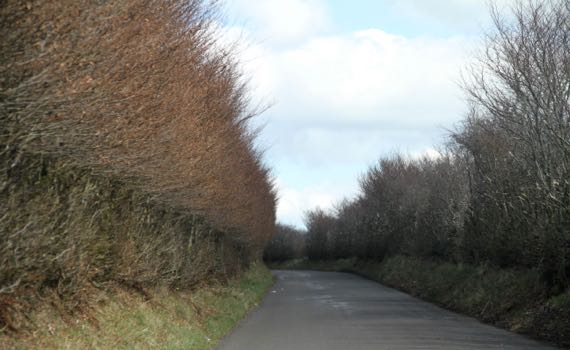
And on Exmoor (our last moor, I think), elaborate hedging…and the secret of how they’re made was revealed to us along this stretch—no photos; too fascinating to snap, just looked. So, here’s the secret to that dense vegetation. About 10cm very upright trees in the existing hedge are cut in a not-quite-vertical slice, so that the top is still attached to the root. Then, the branches are sliced off the tops, which are laid down along the top of the existing hedgerow (two parallel rows), and tied together to keep them from springing back up or shifting out of alignment. They must subsequently send up new verticals, making the dense hedgerows we see, along with the horizontals below the verticals.
The hedging on the left has been trimmed mostly I think to give drivers better line of sight, although also to keep branches from brushing vehicles.
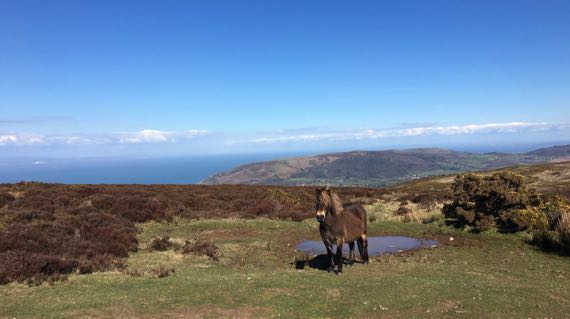
Exmoor pony. That’s Wales on the other side of Bristol Channel, below the line of clouds. We go there tomorrow.
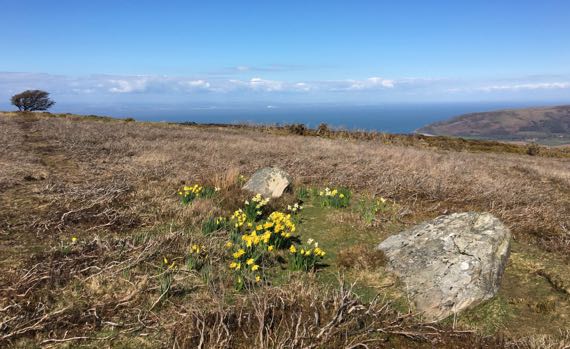
Since it’s a moor, standing stones, right? These two are leaners at this point. And someone’s planted daffodils. We have been enjoying daffodil and primrose season in southern England. We are so lucky with the weather (fingers crossed for the coming days).
Posted at 4:52 PM |
1 Comment »

Of the five castles/fortifications planned to protect the mouth of the River Fal, only two were built, and only this one has the flavor of its architectural roots from 1540–1542. This is St Mawes Castle.
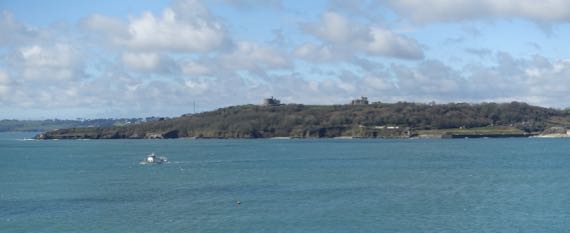
It faces its much modified and much larger opposite number across the river-mouth, now Pendennis Castle.
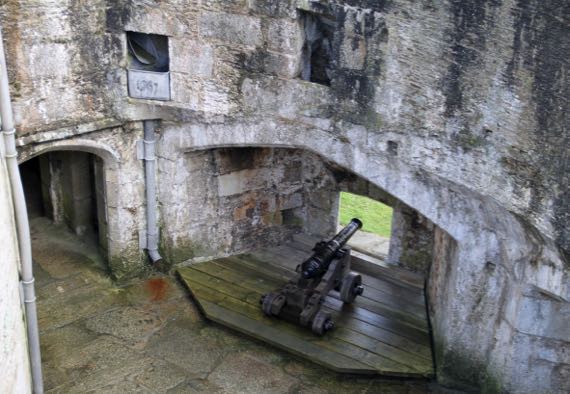
The interior is mostly empty, although cannons still point out their special windows on the ground floor. On one floor curators have placed artful dummies who mostly look like they are waiting for the order to fire.

We opted to skip Falmouth and Pendennis Castle, taking a car-ferry, yippee! (Don’t remember seeing that icon before.)
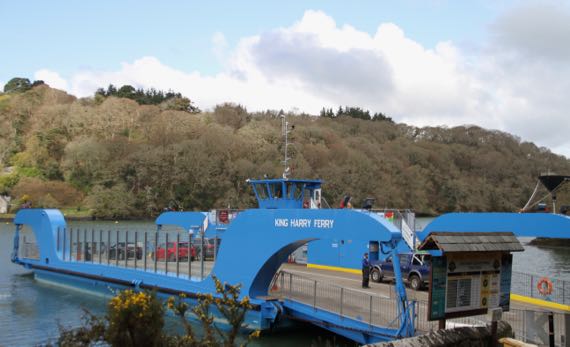
Yup, the King Harry Ferry. £6 please, one way (£8 return, a great deal for those traveling in circles).
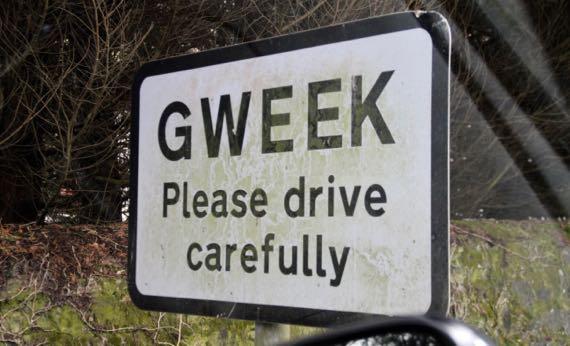
Found a town named Gweek. The car soon filled with no end of puns and word games.

This installation at Goonhilly is now technology so old the contract has been let to remove it. Last chance to see it….
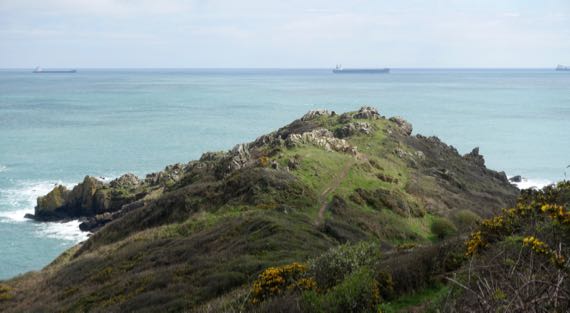
Hiked out this long peninsula with two artificially narrowed bottlenecks. It was used as a fortified promontory fort in the Iron Age, or so They say. The name must have had the word “wind” in it in some form.

Lizard point is Cornwall’s and England’s southernmost (on the mainland). The name is from the pre-Celtic/Cornish lis meaning court and ard/ardh meaning high. The name thus refers to a locally important building here.
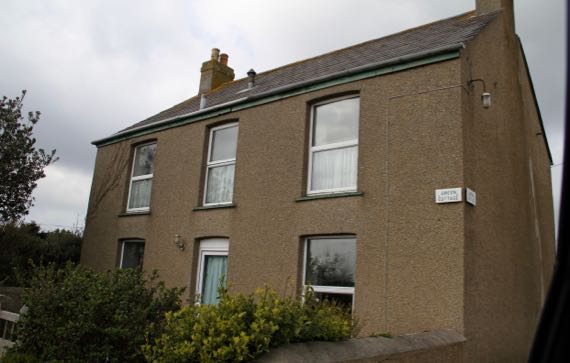
And, what a surprise, right there on the north side of Lizard (town)! Not green…just saying. [Sorry; sign says GREEN COTTAGE.]
Posted at 10:22 PM |
2 Comments »

We “did” more than Dartmoor, but Dartmoor was a highlight. And we didn’t “do” Dartmoor; we just cut through a slice of it. This part was remarkable for the narrow two-way roads, deeply incised into the terrain, with poor visibility very far ahead to spot oncoming traffique.

There are Dartmoor ponies. I don’t know if this is one. It looks rather like a pony, and not a horse. And we saw it on Dartmoor. Conclusions are up to you.
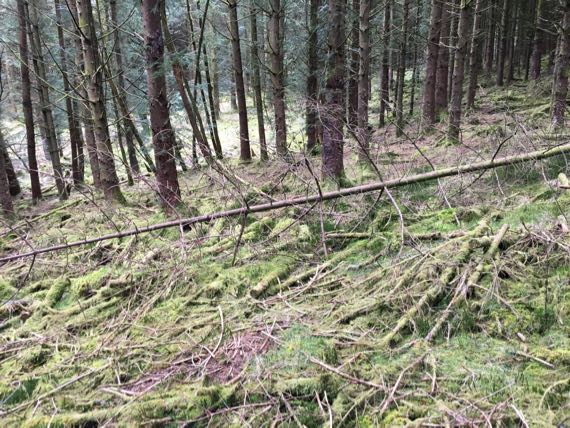
We set off walking on a route I had charted from afar, and quickly realized that we needed to turn back. This lovely forest primeval is just a pine plantation on moor-steroids, meaning that you walk on soft ground, wet in some places. It is not unlike walking on moist sand, requiring a LOT of energy…so we turned back. That’s adventure.

This is called a clapper bridge, and is in Postbridge in the center of Dartmoor. Clapper bridges are stone slabs on a line of piers that cross a river, often near a ford. Interesting conjunction. (If WikiPee is right.) They are essentially Medieval…. We visited this bridge in 1989 during our honeymoon….
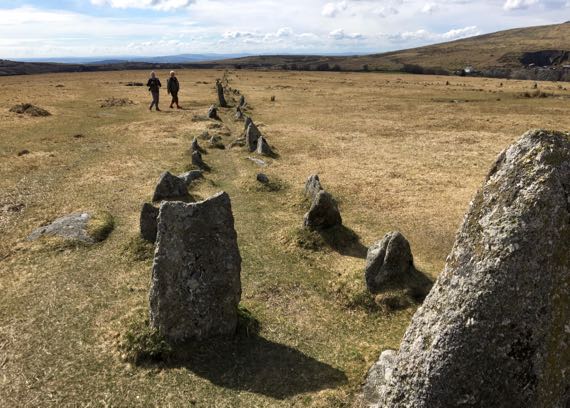
Stone alignments on western Dartmoor…. One of these fellows told us that this pair of stone alignments are 87cm apart, and align with the rising of the Pleiades in 1600BC. There are actually two pairs of Pleiades alignments here, with the other ever so slightly differently oriented, which he said fit with 2000BC. We also saw a stone circle and individual standing stones, and more. Plus what they call “hut circles,” which could have been circular foundations for low-walled buildings. Or for cattle pens. I have seen no excavation data and soil testing on these constructed features.
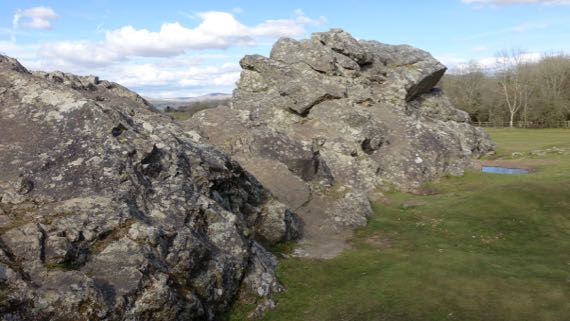
The rocky tops of the rounded crests of Dartmoor “peaks” are called tors. My dictionary notes: “Old English torr, perhaps of Celtic origin and related to Welsh tor ‘belly’ and Scottish Gaelic tòrr ‘bulging hill.’” If this were on a hill it would be a tor, but it is next to an abandoned WWII airfield called Harrowbeer.
Posted at 4:07 PM |
Comments Off on Dartmoor day
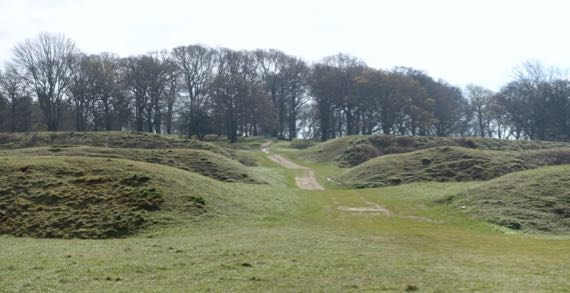
Looking up at the west entrance to Badbury Rings hill fort. These tend to have begun as Neolithic enclosures, later modified into Iron Age ring/hill forts. This entrance has several rows of deep ditches/high berms to control access or impress non-locals.

Its wildflowers are these little yellow ones.
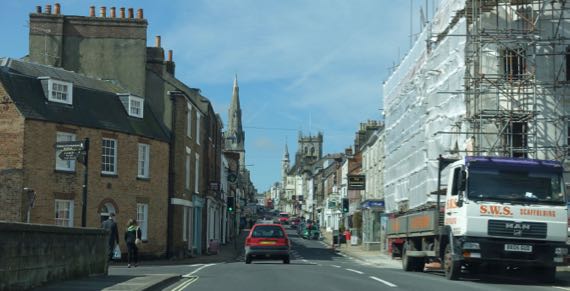
Street view, Dorchester.

Homemade parking lot sandwich: cheddar and rocket on a stale bun. Mmmmm!
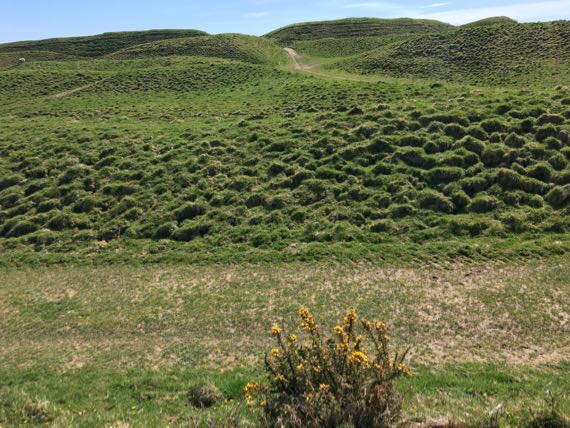
Our lunch view: the giant Maiden Castle, similar history to above, with even more complex berm-ditch entry area (west end). Note grazing sheep.
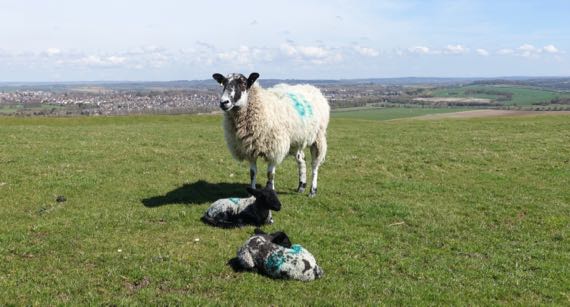
Sheep are an easy way to maintain these grassy archaeological pastures. Twin lambs should make the farmer happy. Dorchester in background.
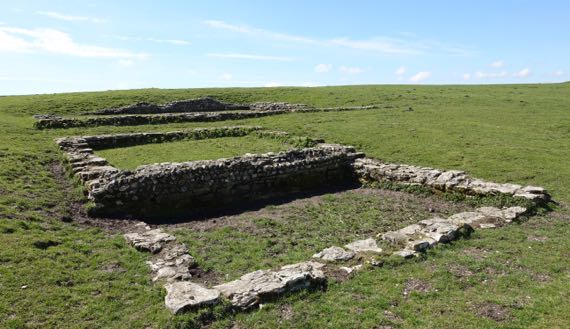
Archaeologists(?) have revealed this Celtic-Roman temple atop Maiden Castle…the altar is in the far room; these two small rooms (foreground) were where its tender lived; the treasure was here, including a piece of metal with Minerva on it (so, a Minerva temple?). We saw this pattern in Rome, too, where the gelt was kept in separate rooms.
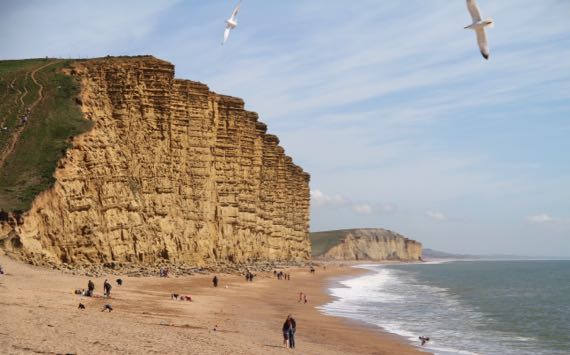
Jurassic cliffs bordering West Bay, aka Broadchurch for you fans of British television. En route, we passed the turn to Chesil Beach, but didn’t take it. Choices, choices.
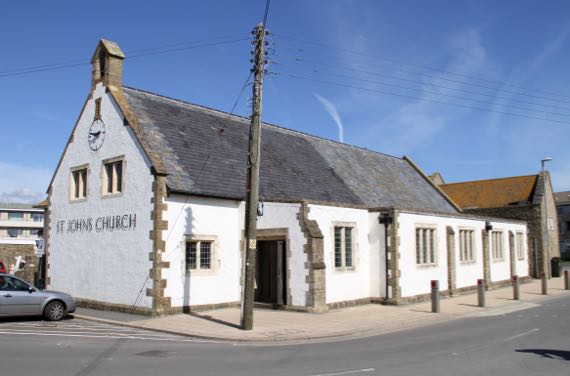
Small church, West Bay.

DI Hardy’s house, the blue-blue one with the narrow double doors and colorful floats/bumpers, West Bay, just up the river channel from the marina, and behind the bathing gulls.
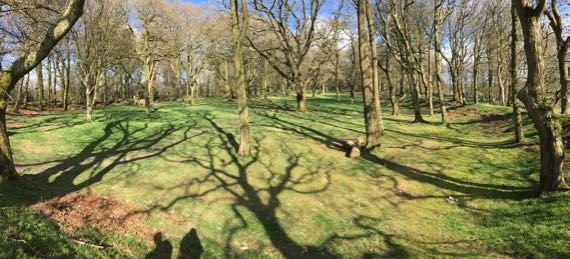
Blackbury Camp is a much smaller fortification above Sidmouth (mouth of the River Sid, eh?). The late-day light was stunning, with the leaves not yet out.
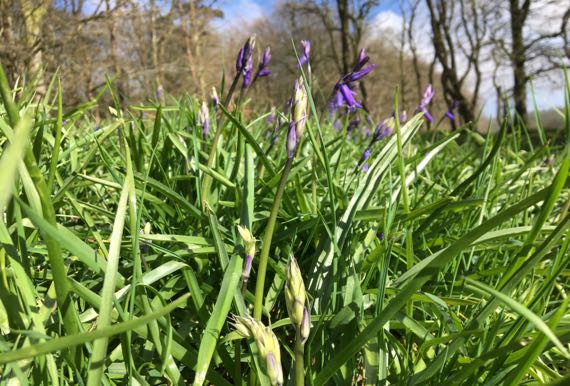
The most prominent flower here: bluebells. Very Broadchurch, second season.
That’s it for hill forts for a while. Conclusion: with the great ascent of Maiden Castle in the mix, average ring-fort ascent is about 25 Fitbit flights (otherwise, much less, thinks the cynic).
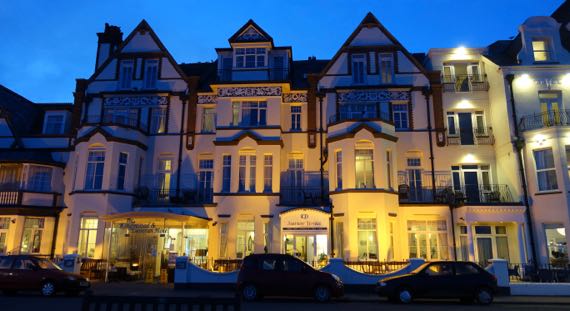
Post-dinner perambulation past fancy waterfront Sidmouth hotels….
Posted at 10:22 PM |
Comments Off on Hillfort-wildflower combos, etc.

We heard rain all night, and into the morning. We’re still on not-quite British time, so I made coffee a bit late. Then we headed downtown to secure a parking space (tricky), and walked to the cathedral to be wowed by the craftsmanship and immense enclosed space, while simultaneously ignoring the awful things the Catholics and their daughter-clan, the Church of England have done.
Without a doubt, the interior space is stunning, all those vaulted arches, the stone imported from afar(?), and carved stone and wood details.
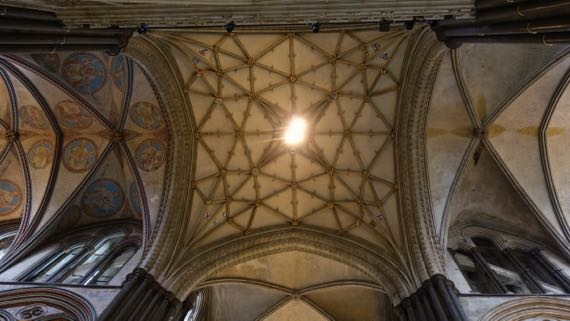
Here’s the ceiling under the spire, which is atop the crossing of the transept. The supporting columns are no longer vertical from the great weight they shoulder. We saw the little tags that the historic preservationists use to monitor small movements (targets for laser-measuring devices).
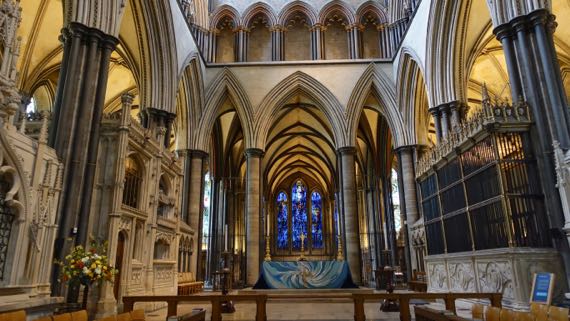
The quire. I don’t know if singers are a quire also, or a choir.
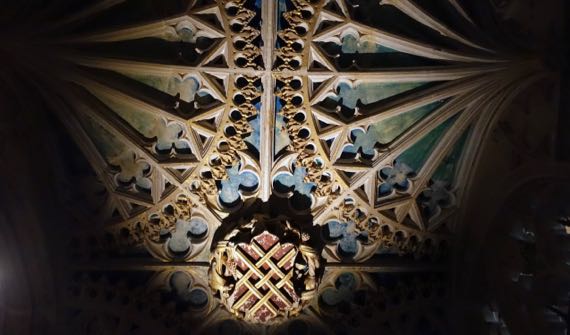
Up near the altar, inserted with access from a side aisle, is a little enclosure, the Chantry Chapel. Here’s a detail of the ceiling. Much of the paint is gone from the rest of the church, so it is a surprise and refreshing here.
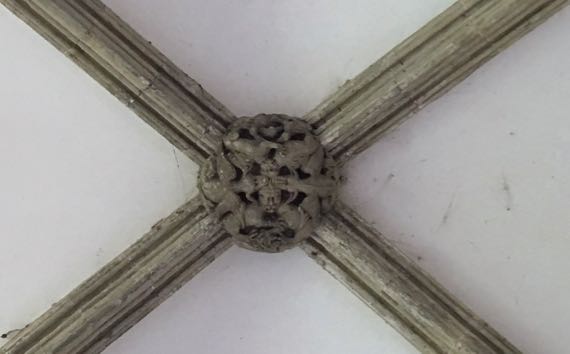
Here’s a detail of life and death tangling on the ceiling above the Cloisters perimeter walkway.
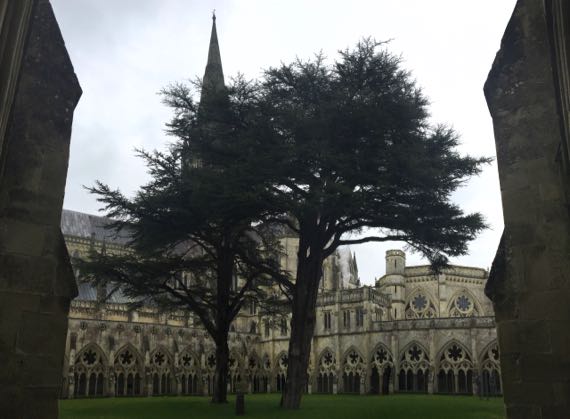
My eyes kept drifting toward this pair of evergreens in the middle of the Cloisters—otherwise there was no attempt at a central garden.

Of course we went in the Chapter House to see the 1215 Magna Carta (one of four), in a little dark room that reminded me of the breast-feeding or milk-expressing pod I saw at the airport in size and lack of windows. This CH is circular, with arm-chair width niches surrounding the room, and a carefully needle-pointed cushion in each. I’m assuming the notables actually perch on them, which seems rather strange to me—as each had the name of a saint (mostly male), with floral details repeated in the surround. This one was for Teresa of Avila, and says “The Way of Perfection.” There’s a potentially hugely stressful approach to life….
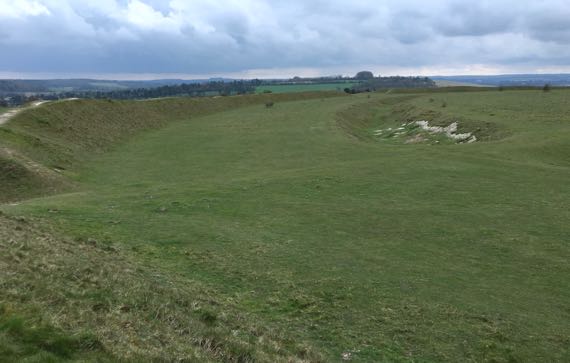
Instead of thick stone walls, this Neolithic henge became an Iron Age hill fort, using ditches and a high berm to provide safety. The henge is the central ring-ditch, surrounding the village area, and is specifically a causewayed enclosure (it seems). The later occupants dug a second ditch farther out, and used the fill to create a circular berm, making two ditches. The entrance are to the east and west (not exactly), and the west break in the wall faces Old Sarum exactly. Must be deliberate. It can just be seen in the distance. Must have been the plan. Some speculate that cattle would have been kept nightly in the space between the inner ditch and the berm. (From left to right: outer berm (outer ditch not visible); Iron Age flat area; Neolithic henge ditch—perhaps deepened by later peoples—and inner village area.)
Posted at 3:49 PM |
Comments Off on Architectural security
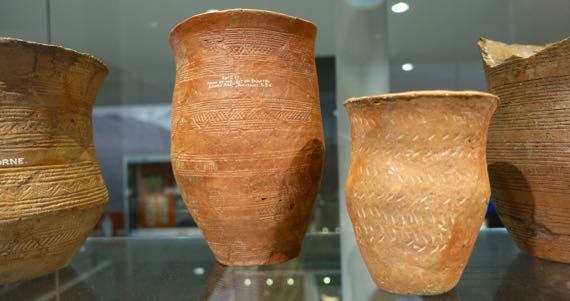
We were slow this morning, jet-lag slow. On the other hand, we did pretty well after we got going. We returned to downtown, parking above the Boston Tea Party mentioned yesterday, and went straight to the Salisbury Museum. The ambitious crew there has been updating the displays and presentation of the institution, and they are doing a fantastic job. We met two fellows from here last year, and so the SM was tops on our list for this trip. Unfortunately, our friend is away on leave, but he kindly left our names at Reception, so we breezed in. People can be so nice! I loved their new-as-of-2014 Wessex Gallery (of archaeology), and the Guru admired their handling of type and general museum-ing.
This photo is of some fine-quality beakers. Beakers are a vessel form with relatively straight/vertical sides, and often a slightly everted rim. (I think.) The earliest beaker-users in this area also kept domesticated animals, including cattle. This meant they had to do the whole pasture thing, and keep the cattle safe from human and animal marauders, a significant undertaking for the few individuals an extended family or residents of a hamlet. They also grew crops, and used wild foods.
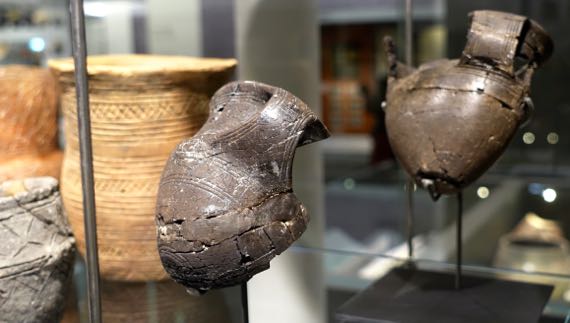
There is another class of artifacts dating back to ancient times, also Bronze Age like the beakers, which I have seen called “precious cups.” They are precious because they are made of very special (meaning unusual/rare) materials, including amber, gold, silver, and these of shale. There are very few precious cups known, and the shape may relate to a general tendency towards what some have characterized as a “drinking culture.”
I didn’t know shale could be worked like this. Note the decorative details inscribed into the surface and handle. Such craftsmanship!
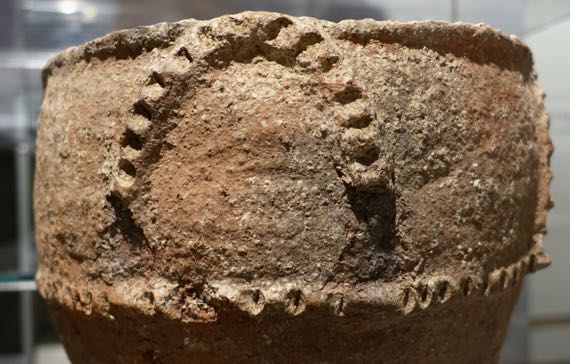
Here’s a detail of a very large vessel, a burial urn (held cremated human remains) with a bi-conical shape. The widest part is the ridge near the bottom of this shot. The size of this ceramic vessel meant its maker(s) knew how to handle clay and firing.
The above all date to the Bronze Age, which obviously was a time of people who used bronze, but they were also adept at crafting, building, wood-working, and making stone tools. Let’s jump forward in time….
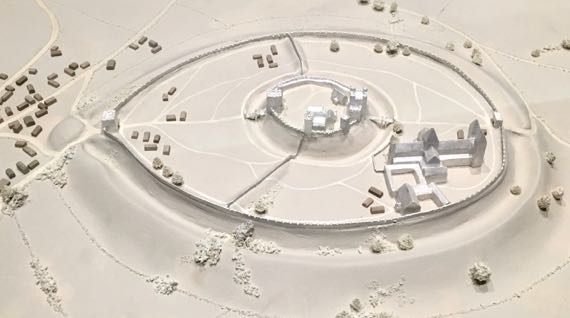
There’s a huge and distinctive flat-topped conical landform a few miles north of Salisbury. It had an Iron Age fort atop it, which was supplanted by Romans both atop and around the foot, living in a community they called Sorviodunum…. They had several roads that met near this human-modified landform, so it was an important place. Later peoples added the tippy-top area, making what became in William the Conqueror’s time the king’s castle. This model shows the tower/keep that was the most fortified place within this already fortified place was to the right in the upper, central area. The main entrance was from the left. Residents of the lower tier even built a cathedral-sized cathedral (consecrated in 1092), that huge building what was a typical church/abbey complex in the lower right quarter of this view. It is difficult to gauge the scale of this fortification with just the eye; however, it wasn’t big enough (or something), and movers and shakers set about re-locating the community so that their new cathedral was consecrated in 1220, and the old cathedral dissolved in 1226. Sometimes I mention the abandonment of former important macro-regional centers of political economy—the story of Old Sarum fits neatly into this topic.
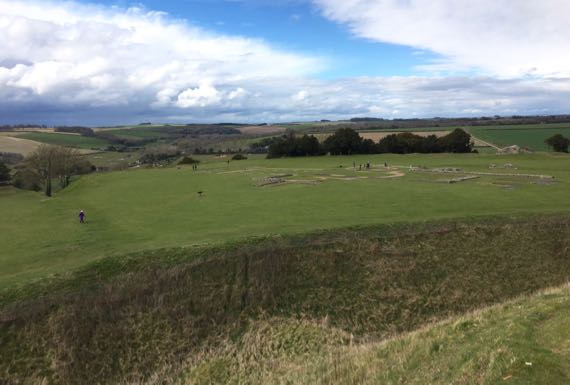
Here’s the view from the King’s Castle keep, looking across the flattened remains of the cathedral. Most of the building stone was left at Old Sarum into the 1500s, when official permission was given to take it. Only some foundation stones remain in the upper castle, with upper approximations of the walls made of mortared flint cobbles that had been in the wall-fill, and too small to be of interest to the long-ago stone-takers. The cathedral and buildings of the lower terrace were easier to get to, and they are mostly gone. The outline is only partly existing foundation stubs; the rest have been added in modern times. This area is happily used by dogs and dog-owners; we saw dozens playing and running/walking (dogs/people) as we overlooked the terrace from the remains of the king’s apartments.

Here’s the modern wooden footbridge that crosses the ditch (and what a ditch!) from the east, providing access to the inner, upper castle area. Note how the weather is changing…the bright sky of the previous shot shows grey clouds accumulating. We got back to the car just as the raindrops arrived. The rain didn’t last long, and we had plenty of sun until darkness set in about 8pm. (And there’s now a crescent moon.)
Info on beakers and beaker-making people from the Ashmolean. Details on similar from a Somerset source—Somerset is the next county to the WNW.
Posted at 3:30 PM |
Comments Off on Ancient and merely old (Wiltshire version)

























































































